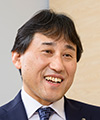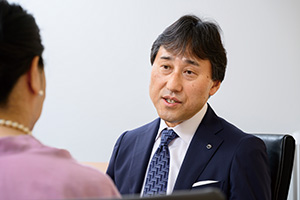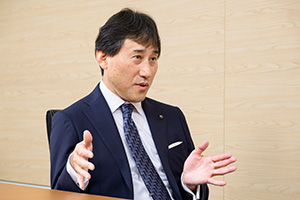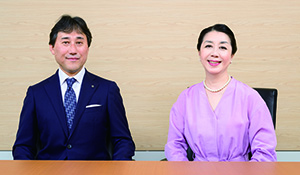 |
|
|
|
|
|
View from the Top Vol. 23, No. 10, pp. 1–6, Oct. 2025. https://doi.org/10.53829/ntr202510tp1
People Are Our Most Valuable Asset—Aspire to Be a Leader Who Continues to Illuminate Both Our Employees and SocietyAbstractNTT Infrastructure Network Corporation (NTT InfraNet) is tackling a variety of social challenges, such as aging facilities, labor shortages, environmental issues, and disaster prevention, by applying the technical capabilities it has cultivated through its business—namely, providing Information and communications infrastructure—and co-creation with its partners. The efforts of NTT InfraNet to contribute to the optimization and sustainability of Japan’s social infrastructure as a whole is drawing considerable attention. We spoke with Ichiro Uehara, President of NTT InfraNet, which builds and operates social infrastructure for a new era, about the development of NTT InfraNet’s business and his role as leader. Keywords: social infrastructure, innovation, smart infrastructure NTT InfraNet launches “social-infrastructure innovation”—Would you tell us about the business and vision of NTT Infrastructure Network Corporation (NTT InfraNet)? NTT InfraNet was established in 1999 as a company that supports the underground communications infrastructure in Japan. Operating for nearly a quarter of a century, we manage the communications infrastructure, including the tunnels and underground conduits, originally owned by the NTT Group. The total length of the conduits alone is about 670,000 km, which equals the total length of the Japan’s water-supply system. We are currently promoting “social-infrastructure innovation,” which applies the technology and expertise we use to maintain and operate the communications infrastructure in the fields of not only information and communications but also the social infrastructure owned by infrastructure operators and local governments, such as electricity, gas, and water. To develop social-infrastructure innovation as a business, we have established two major pillars. The first is our infrastructure-engineering business, which involves working with local governments and other road administrators to design, construct, and coordinate social-infrastructure projects such as removal of utility poles and the construction of private renewable energy lines. The other is our smart-infrastructure business, which uses digital transformation (DX) to promote infrastructure-management businesses such as smart maintenance and spatial-management businesses such as electronic maps. Working together as a pair, these two businesses will lead to social-infrastructure innovation. As for the background to social-infrastructure innovation, many infrastructure operators, including us, and local governments are currently facing similar challenges, such as aging facilities, disaster risks, a shortage of engineers, and budgetary constraints. NTT InfraNet has formed a community with other infrastructure operators, such as those in the electricity, gas, and water sectors, and through this community, we plan to solve common challenges by sharing applications and resources related to the operation and maintenance of our infrastructure facilities. We therefore began working on solving social-infrastructure issues by thinking from the perspective of social infrastructure as a whole—rather than individual pieces of infrastructure—and collaborating within the community. While the business concerning information and communications infrastructure is almost saturated, I believe that by taking this social-infrastructure-innovation-based approach including other sectors, we can utilize our strengths to develop new business.
—This initiative really shows the NTT spirit of taking on social issues. Is it progressing smoothly? It has both positive and negative aspects. One positive aspect is that we have received support for social-infrastructure innovation from other infrastructure operators and local governments, and the sharing of our systems within the above-mentioned community and resources is beginning to function well. On the contrary, facility conditions and environments depend on the local government and infrastructure operator; consequently, our efforts have not yet been scaled, and data sharing, which is important for promoting DX, has not yet reached an ideal form. As urban development progresses and technological development accelerates, we are constantly considering and optimizing how to maintain and utilize existing infrastructure and how to build new infrastructure. For example, in the case of removal of utility poles, which is increasing in our infrastructure-engineering business, we are achieving shorter construction periods and cost reductions by promoting the “construction method utilizing the existing stock,” which makes effective use of existing communications and power facilities. Moreover, removal of utility poles takes time because adjustments with infrastructure operators, such as the electric power company that owns the utility poles and the gas company that installs gas pipes under the poles, as well as with surrounding residents and the police are requred. However, by using PFI (private finance initiative) projects and comprehensive outsourcing schemes, NTT InfraNet can handle these adjustments on behalf of road administrators and thereby significantly shorten construction periods. Regarding our smart-infrastructure business, NTT InfraNet provides a “web-based construction-attendance appointment system,” which allows for one-stop digital requests for construction attendance to multiple infrastructure operators. This system reduces the burden of preliminary surveys and coordination discussions on infrastructure operators and local governments. To date, 60 infrastructure operators have used this system, receiving approximately 100,000 construction-attendance requests per month. And in areas other than telecommunications infrastructure, our “smart-maintenance tool” (which is used to inspect telecommunications infrastructure) is also being used to inspect sewerage infrastructure. This tool thereby provides one way for local governments to address the aging of sewerage systems and the decline in the number of engineers. We are also currently participating in the Comprehensive Nationwide Development Plan for Digital Lifeline, which is being promoted primarily by the Ministry of Economy, Trade and Industry. The Infrastructure Management DX project aims to obtain location information about underground structures by using high-precision three-dimensional (3D) absolute coordinates. Although 2D location information about underground structures has traditionally been managed using geographic information systems and computer-aided design and has thereby been prepared to a certain extent, 3D location information of 3D models of underground structures has not been prepared. By converting this information to 3D with high precision and unifying various interfaces, it is possible to improve safety by visually displaying the buried status of underground facilities on the operation screen of excavation machinery during digging. In the event of a disaster, it is possible to aggregate damage status and recovery information about each piece of infrastructure and display it on the screen of a disaster-prevention app in a manner that speeds up recovery planning. Through these efforts, we will leverage our technology and expertise to build the livable cities of the future.
Our new purpose: “Building new social infrastructure and connecting it to the next generation”—NTT InfraNet has been growing steadily over the two years since you became president. Do you feel a sense of accomplishment? NTT InfraNet has been growing over the past few years in terms of increasing revenue and profits. As mentioned above, our business has mainly focused on NTT’s information and communications infrastructure; however, now our main focus is external work, particularly social contribution through social-infrastructure innovation. Two years ago, sales from business concerning NTT and sales from external businesses reversed, and this trend has become more pronounced. Over the past two years, I have found it rewarding to have all our employees understand this new direction and move forward together facing in the same direction. Recognizing this change in the role of NTT InfraNet, we have worked to establish our purpose in order to move even further ahead. In establishing our purpose, we sought the opinions of our employees and held numerous discussions. The new purpose that we have established is “building new social infrastructure and connecting it to the next generation.” It might be a simple phrase, but it has many meanings behind it. Needless to say, new social infrastructure is not just information and communications infrastructure; rather, it is infrastructure for society as a whole. Moreover, rather than simply remaking what already exists, we must make it sustainable and “connect” it to the future. Although infrastructure tends to center around hardware, it also includes software aspects such as platforms and applications as well as new ways of working and mechanisms such as ordering and construction methods. Rather than simply sharing the purpose statement, we are thinking about its meaning together with our employees and fostering shared values. To that end, we are holding dialogue sessions with employees at business divisions across Japan and branches in all 47 prefectures and thereby providing opportunities for discussion about the meaning and significance of our purpose. At these dialogue sessions, I hear about examples of initiatives that transcend existing fields while taking into account the “real world” on the ground. For example, it makes me happy to hear about initiatives that demonstrate flexible thinking that transcends fields, such as handling work across multiple infrastructure providers in one stop or utilizing our telecommunications-infrastructure inspection expertise and systems for other infrastructure. I believe that it is precisely because of the relationships of trust we have built with local governments and other organizations that we are able to innovate and take on challenges that transcend fields. —It’s great to see employees taking the initiative in their work. What do you value when leading such employees? NTT InfraNet is a serious company in a way that is a unique—and positive—characteristic of the facilities departments of the NTT Group. Large-scale projects can take a long time to complete, so I feel that many employees take their work seriously while using the technology and expertise on infrastructure systems that have been passed down. In my previous position as senior executive vice president of NTT WEST, I had someone to consult with, namely, the president, but the difference with my current position of president is that I ultimately have to think about the future of the company myself. In the back of my mind, I began to feel more and more like I was the last line of defense and the final decision maker. To lead diligent employees, when making decisions, I place importance on the opinions and thoughts of the people who actually do the work. Large-scale projects in particular involve a lot of external interaction, so I make decisions based on the client’s thoughts and how the world is moving. One of my main priorities as president is how to grow the company in the future. It can be difficult to decide whether to base my decisions on the current business situation or to consider a completely new direction; even so, when making decisions, I follow the motto of “cool head, but warm heart.” It is very important to work with resolve and passion, and even if you think things aren’t going well, you may find a breakthrough if you keep trying and coming up with new ideas. I also realize that it’s important to think calmly, so I’m trying to strike a balance.
The passion cultivated by volunteering for new projects and the importance of calm judgment learned through numerous disaster responses—Would you tell us about your background and how it led to your thoughts and attitude of wanting to be passionate and calm at the same time? I joined NTT in 1988, the last year of the Showa era in Japan and right on the brink of the “bubble economy.” It had been three years since the company evolved from Nippon Telegraph and Telephone Public Corporation to NTT, and new challenges were underway in a variety of fields. I started out in the facilities field, in which I worked on the nationwide rollout of optical fiber. At the time, telephone services were mainly provided via metal cables, and I was tackling the issue of how to introduce and utilize optical fiber. At that time, I experienced a facilities-based-competition industry in which NTT owned the facilities and provided services under the idea that optical fiber enabled high-speed communications in a competitive manner. After that, I gained experience in corporate sales and collaborated more with corporate and local customers. As I worked in a variety of partnerships, I always valued the perspective of how we could utilize our facilities and human resources. I’ve now returned to a facilities-related company, and I approach my work from the perspective of considering what to do with the infrastructure as a whole rather than simply making use of individual facilities. In the roughly 40 years since I joined NTT, two experiences led me to the idea of being “passionate yet calm.” As for the first experience, a few years after joining the company, I had the opportunity to be involved in new technologies and projects. As part of the trend of taking on new challenges after NTT was transformed from Nippon Telegraph and Telephone Public Corporation, I volunteered with aspirations and took on new initiatives such as a project to create the telephone exchange of the future using the latest technology and promoting business at a subsidiary. The second experience concerned disaster response. In responding to disasters such as the Great Hanshin-Awaji Earthquake in 1995, the Great East Japan Earthquake in 2011, and the Kumamoto Earthquake in 2016, I experienced both NTT’s mission and DNA of restoring and connecting services and the changing needs of society (from providing temporary telephone lines to Wi-Fi at evacuation centers). I have been in many positions where I was required to make optimal decisions in environments differing from everyday life, such as what to do in the event of a disaster and how to interact with affected customers. This experience has taught me the importance of maintaining passion while also being able to make calm decisions. —What are the future prospects of NTT InfraNet and what message do you have for researchers and engineers? First, from the perspective of “connecting to the next generation” stated in our purpose, we will strive to achieve social-infrastructure innovation by connecting facilities and the entire social infrastructure, and it is important that the company itself, NTT InfraNet, grows and is passed on to future generations. To this end, human resources development is crucial. People are our most valuable asset, and I believe that a president is someone who “becomes a shining light for employees and society.” My role is to illuminate the direction we should take in the future and to help employees shine so that they can all do their best. I believe that seemingly small actions like listening to what employees have to say on the job and remembering their previous conversations can bring out employees’ confidence and the strength of the organization. As the leader, I want to be aware of the influence I have and strive to be a shining light for employees and society. I also feel that society has very high expectations of the NTT Group. The Innovative Optical and Wireless Network (IOWN) initiative, which is being developed with the aim of being implemented by 2030, is also receiving positive reviews at the NTT Pavilion at Expo 2025 Osaka, Kansai, Japan, where visitors can experience the IOWN firsthand. NTT’s cutting-edge technology is highly regarded, and we have high hopes that it will enhance Japan’s national strength and bring social change. We are also proud of the trust we have earned from other infrastructure operators and local governments, who have described us as “the one you can rely on in the end.” I believe the value of this presence is immense. By enabling people to experience NTT’s technology and initiatives at NTT R&D Forum and other venues and communicate with NTT researchers and staff, we hope not only to demonstrate our cutting-edge technology but also to convey our desire to form an alliance and work together. We will continue to use the strengths of the NTT Group, take on challenges together with our employees, and create the future in conjunction with society. Interviewee profileCareer highlightsIchiro Uehara joined NTT in 1988. He served as president and representative director of NTT Neomeit from 2013 to 2017. He became the director of the Corporate Business Headquarters of NTT WEST and president and representative director of NTT Business Solutions in 2017 and senior executive vice president of NTT WEST in July 2019. He has been in his current position since June 2023. |




